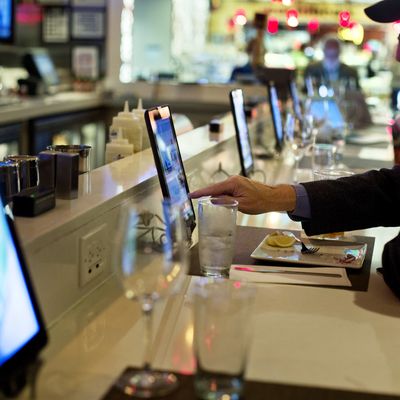
I recently took a United Airlines flight that connected through Newark. On the outbound leg, during my layover, I stopped at one of the full-service restaurants near my gate to eat dinner. Sitting down at the bar, a waiter came over. “You have to use the iPad to order,” he barked. “You can also surf the internet.”
Sure enough, every bar seat and table had iPads set up on little stands. The system was simple enough. You selected from categories like “appetizers” and “kids menu” and “gluten-free,” picked out what you wanted, added it to the tab, and paid, with a credit card or airline miles, if for some reason you wanted to.
Nevertheless, it caused some headaches. The couple next to me wanted martinis, one with a type of gin she could see on the mantle behind the bar but could not order on the iPad. Another older woman, unfamiliar with the technology, struggled to use it at all. I wanted a refill on my soda, but there was no button for “refill,” at least not that I could find. On my return flight, the card reader on my iPad did not work, so a waitress had to come over and input my order into another machine, and then redirect my food to me.
Granted, these are the most first-worldly of first-world problems. And even though I wished I could have just ordered from a human being and avoided the hassle, the system is hardly a total bust. Your ticket goes straight to the kitchen, so it comes out fast, just how you ordered it. Paying for a meal is a cinch, too — no flagging someone down, no concerns about incorrect charges, no worrying and waiting for the check to come back.
And one way or another, this is where the first world is going. Automated systems are perfectly good at taking orders from a standardized menu of items, hence the popularity and ubiquity of the ATM, the movie- ticket machine, and so on. Some restaurants — mom-and-pop shops that lack infrastructure capital, the Per Se types selling a feeling of luxury — will continue to rely on old-fashioned, meat-puppet waiters, no matter what. But in a matter of years, you’ll be ordering many of your fast food, chain restaurant, and airport meals on a tablet, rather than from a human waiter; Newark is part of an early vanguard, along with Buffalo Wild Wings, Chili’s, and Applebee’s.
The advantages for the restaurant are clear. Tablets are cheaper than human waiters, even given how cheap those human waiters are. (The federal tipped minimum wage is just $2.13 an hour.) They nudge consumers to spend a little more than they would otherwise, encouraging them to get appetizers, desserts, or fancier drinks. They also reduce time spent per visit by making the ordering process quicker, leading to higher table turnover and ultimately higher revenue.
I suspect that eventually the advantages for restaurant patrons might come to outweigh the early disadvantages as well. Many of the problems I witnessed at Newark were problems of unfamiliarity. How do you use this thing? Why don’t you come help me? Where is the waiter? Over time, those questions should fade.
It is the servers who will really get the short end of the digital stick here. Ideally, for the restaurant, tablets will both complement human labor and supplement it. You’ll need fewer waiters, and the ones that you retain will become more productive and efficient. But at the moment, the tablets are forcing waiters to do more work, rushing around to aid confused and angry patrons. And on top of that, they have to wait tables festooned with the cute iPads that will in time put them out of a job.
No wonder that waiter seemed so hostile.





























